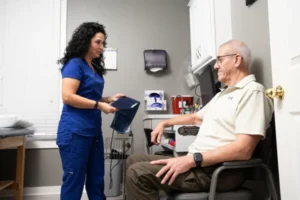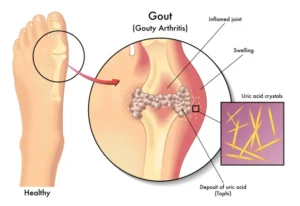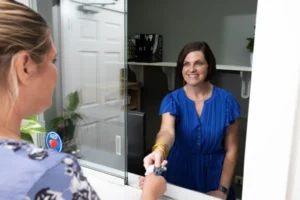What to Expect: A Day in Our Gout Clinical Trial
 Gout can be a painful and disruptive condition, significantly affecting daily life with sudden flare-ups and persistent joint discomfort. If you are looking for new ways to manage your gout symptoms, consider clinical trials and how participating could benefit both you and others living with the same condition. At Quality Research in San Antonio, we conduct clinical trials focused on gout to evaluate promising new treatments.
Gout can be a painful and disruptive condition, significantly affecting daily life with sudden flare-ups and persistent joint discomfort. If you are looking for new ways to manage your gout symptoms, consider clinical trials and how participating could benefit both you and others living with the same condition. At Quality Research in San Antonio, we conduct clinical trials focused on gout to evaluate promising new treatments.
Many people are curious about what happens during a clinical research study but are unsure about what to expect. In this blog, we will walk you through a typical day as a participant in our gout clinical research study while also addressing some common questions about gout, including:
– What triggers a gout attack?
– What are the warning signs of gout?
– Can gout go away?
Whether you are thinking about participating or want to learn more, this guide will provide clarity, confidence, and insight into what it’s like to participate in meaningful medical research.
Starting the Day: Arrival and Check-In
 Your day at the clinic starts with a smooth and friendly check-in process. When you arrive at our research site in San Antonio, our staff will greet you and guide you through a brief intake process. A dedicated research coordinator will review your information, explain the agenda for your visit, and ensure that all your questions are answered.
Your day at the clinic starts with a smooth and friendly check-in process. When you arrive at our research site in San Antonio, our staff will greet you and guide you through a brief intake process. A dedicated research coordinator will review your information, explain the agenda for your visit, and ensure that all your questions are answered.
From the very beginning, we strive to make your experience welcoming and stress-free. Whether this is your first time participating in a clinical study or you have been involved before, we treat every participant as a valued partner in advancing medical science.
Initial Evaluation: Understanding Your Health
 Next, you will meet with a clinical team member for a brief health evaluation. This will include:
Next, you will meet with a clinical team member for a brief health evaluation. This will include:
– Reviewing your medical history
– Discussing your gout symptoms and recent flare-ups
– Checking your vital signs
– Drawing blood for lab work (if applicable)
During this meeting, we will also explore your specific experience with gout. Many patients report sudden, intense joint pain, particularly in the big toe. This is a common warning sign of gout, along with symptoms such as swelling, redness, and heat in the affected joint. You can refer to this helpful guide from the Mayo Clinic for a more comprehensive overview of symptoms.
Understanding Gout: Triggers and Causes
 Before proceeding with the trial, it’s essential to understand what might be triggering your gout. According to the Mayo Clinic, gout attacks are typically prompted by high levels of uric acid in the blood, which can create sharp crystals in the joints. These increases in uric acid may be caused by:
Before proceeding with the trial, it’s essential to understand what might be triggering your gout. According to the Mayo Clinic, gout attacks are typically prompted by high levels of uric acid in the blood, which can create sharp crystals in the joints. These increases in uric acid may be caused by:
– Diets high in red meat or seafood
– Alcohol consumption, particularly beer
– Sugary drinks or excessive fructose intake
– Dehydration
– Obesity or certain medications
– Physical trauma or stress
By tracking your triggers, you can manage your condition more effectively. Our clinical team will help identify patterns and gather insights that may guide your treatment both during and after the study.
Receiving Study Medication or Placebo
 After the initial evaluation, you may receive either the investigational treatment or a placebo, depending on the study protocol. This process is conducted with your full knowledge and consent, and it is closely monitored by our research professionals.
After the initial evaluation, you may receive either the investigational treatment or a placebo, depending on the study protocol. This process is conducted with your full knowledge and consent, and it is closely monitored by our research professionals.
Your safety and comfort are our top priorities. You will be observed for a short time after taking the medication to ensure that no immediate side effects occur. The data we collect during this process is essential for understanding how well the medication works and how it could benefit others in the future.
Can Gout Go Away?
 One of the most frequently asked questions we receive is: Can gout go away? The answer is both yes and no. While gout cannot currently be “cured,” it can go into remission or be managed so effectively that flare-ups become rare or nonexistent. This is often achieved through a combination of medication, lifestyle changes, and avoiding triggers. Participating in a clinical trial can provide access to new and potentially more effective treatments that may lead to a lasting difference in your life.
One of the most frequently asked questions we receive is: Can gout go away? The answer is both yes and no. While gout cannot currently be “cured,” it can go into remission or be managed so effectively that flare-ups become rare or nonexistent. This is often achieved through a combination of medication, lifestyle changes, and avoiding triggers. Participating in a clinical trial can provide access to new and potentially more effective treatments that may lead to a lasting difference in your life.
Observation and Follow-Up
After taking the study medication, you will remain in the clinic for observation. Our team will check your vital signs and ask about any changes in how you are feeling. Before you leave, you will receive detailed instructions about what to expect next and when to return for follow-up visits.
Some studies require regular visits over several weeks, while others may only have a few scheduled check-ins. Regardless, we aim to make the process as convenient and transparent as possible. Our goal is to ensure you feel supported throughout your entire journey.
Why Your Participation Matters
By participating in our gout clinical research study, you are helping yourself and contributing to crucial research that could lead to more effective treatments for millions of others suffering from this painful condition. Clinical trials are essential for advancing medicine, and your involvement is vital.
At Quality Research, we prioritize the well-being of our participants. Our team is trained not only in research but also in providing compassionate care. We understand the challenges of living with gout and strive to make your participation worthwhile, respectful, and safe.
Please visit the Gout Clinical Research Study page to learn more about our current study.
 Final Thoughts: Take the First Step Toward Relief
Final Thoughts: Take the First Step Toward Relief
Gout doesn’t have to dictate your life. If you’re dealing with frequent flare-ups or seeking new treatment options, participating in a clinical trial could provide you with new avenues for relief and healing.
If you want to explore a new path and contribute to important medical advancements, consider joining our study. You’ll be supported by a team that understands your needs, respects your time, and values your contribution.
Ready to Learn More?
Contact Quality Research today to see if you qualify for our gout clinical trial in San Antonio. Your participation could make a significant difference for yourself and for the future of gout treatment.

